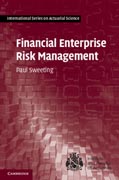
Financial Enterprise Risk Management provides all the tools needed to build and maintain a comprehensive ERM framework. As well as outlining the construction of such frameworks, it discusses the internal and external contexts within which risk management must be carried out. It also covers a range of qualitative and quantitative techniques that can be used to identify, model and measurerisks, and describes a range of risk mitigation strategies. Over 100 diagramsare used to help describe the range of approaches available, and risk management issues are further highlighted by various case studies. A number of proprietary, advisory and mandatory risk management frameworks are also discussed, including Solvency II, Basel III and ISO 31000:2009. This book is an excellent resource for actuarial students studying for examinations, for risk managementpractitioners and for any academic looking for an up-to-date reference to current techniques. ÍNDICE: Preface; 1. An introduction to ERM; 2. Types of financial institution; 3. Stakeholders; 4. The internal environment; 5. The external environment; 6. Process overview; 7. Definitions of risk; 8. Risk identification; 9. Someuseful statistics; 10. Statistical distributions; 11. Modelling techniques; 12. Extreme value theory; 13. Modelling time series; 14. Quantifying particularrisks; 15. Risk assessment; 16. Responses to risk; 17. Continuous considerations; 18. Economic capital; 19. Risk frameworks; 20. Case studies; Index.
- ISBN: 978-0-521-11164-5
- Editorial: Cambridge University
- Encuadernacion: Cartoné
- Páginas: 564
- Fecha Publicación: 31/08/2011
- Nº Volúmenes: 1
- Idioma: Inglés
